Report: Patient Management System Analysis at St. George Hospital
VerifiedAdded on 2021/05/31
|14
|3492
|70
Report
AI Summary
This report provides an executive summary and detailed analysis of the patient management system at St. George Hospital, a cancer care center. It examines the current patient flow, queuing systems, and their functional abilities, highlighting challenges such as long waiting times, inefficient layouts, and bottlenecks in the patient journey. The report outlines various factors contributing to delays, including staffing issues, test result delays, and scheduling problems. It also explores the benefits of a smooth patient flow, such as increased customer satisfaction and improved efficiency. The report offers recommendations for improvement, including principles of good patient flow management, such as observing patient movement patterns, separating patient and staff flows, and utilizing patient flow software for automation and analysis. Additionally, the report suggests implementing chart audits and flow mapping methods to identify and address process failures and redundancies, ultimately aiming to enhance the overall patient experience and operational efficiency of the hospital.
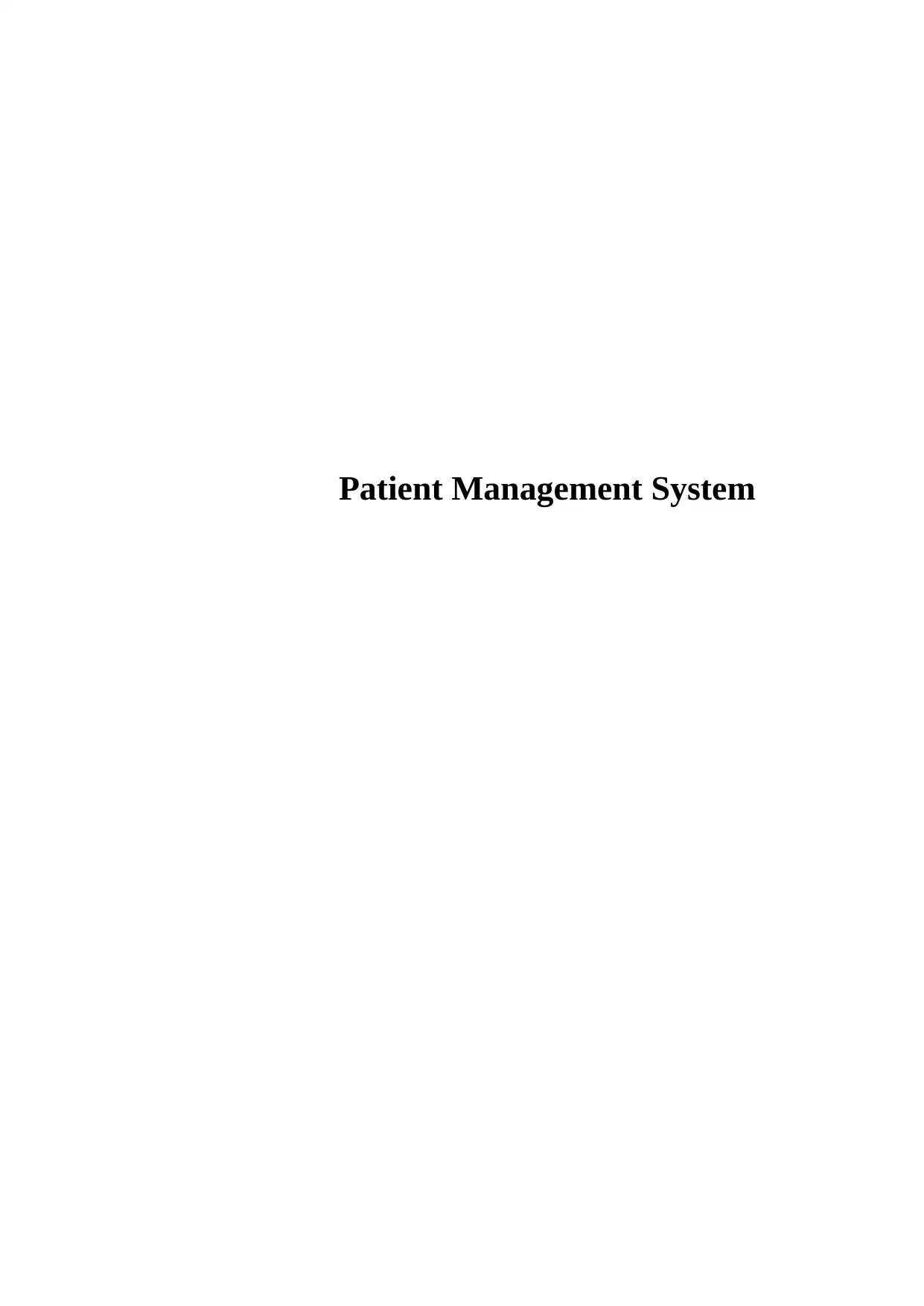
Patient Management System
Paraphrase This Document
Need a fresh take? Get an instant paraphrase of this document with our AI Paraphraser
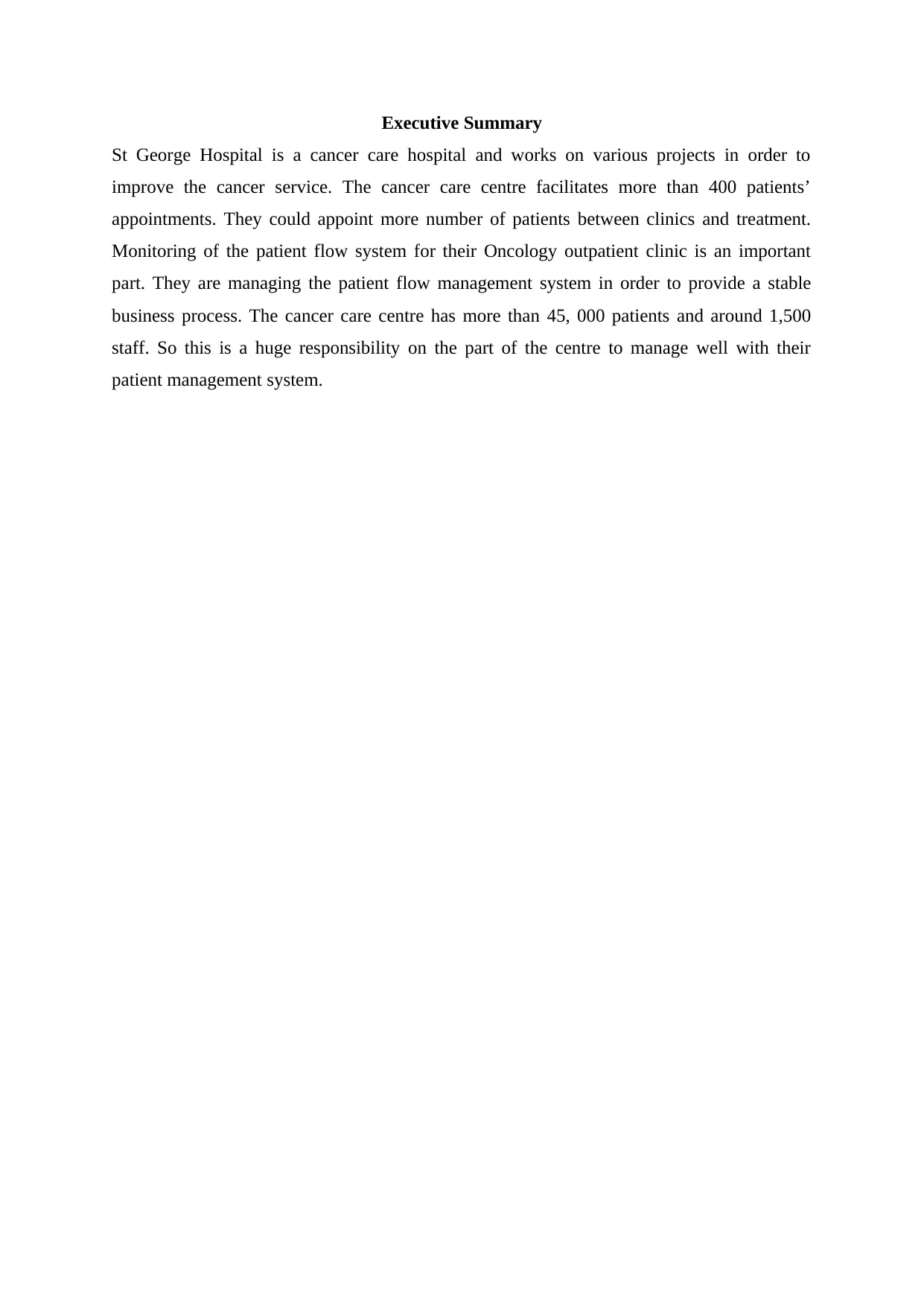
Executive Summary
St George Hospital is a cancer care hospital and works on various projects in order to
improve the cancer service. The cancer care centre facilitates more than 400 patients’
appointments. They could appoint more number of patients between clinics and treatment.
Monitoring of the patient flow system for their Oncology outpatient clinic is an important
part. They are managing the patient flow management system in order to provide a stable
business process. The cancer care centre has more than 45, 000 patients and around 1,500
staff. So this is a huge responsibility on the part of the centre to manage well with their
patient management system.
St George Hospital is a cancer care hospital and works on various projects in order to
improve the cancer service. The cancer care centre facilitates more than 400 patients’
appointments. They could appoint more number of patients between clinics and treatment.
Monitoring of the patient flow system for their Oncology outpatient clinic is an important
part. They are managing the patient flow management system in order to provide a stable
business process. The cancer care centre has more than 45, 000 patients and around 1,500
staff. So this is a huge responsibility on the part of the centre to manage well with their
patient management system.
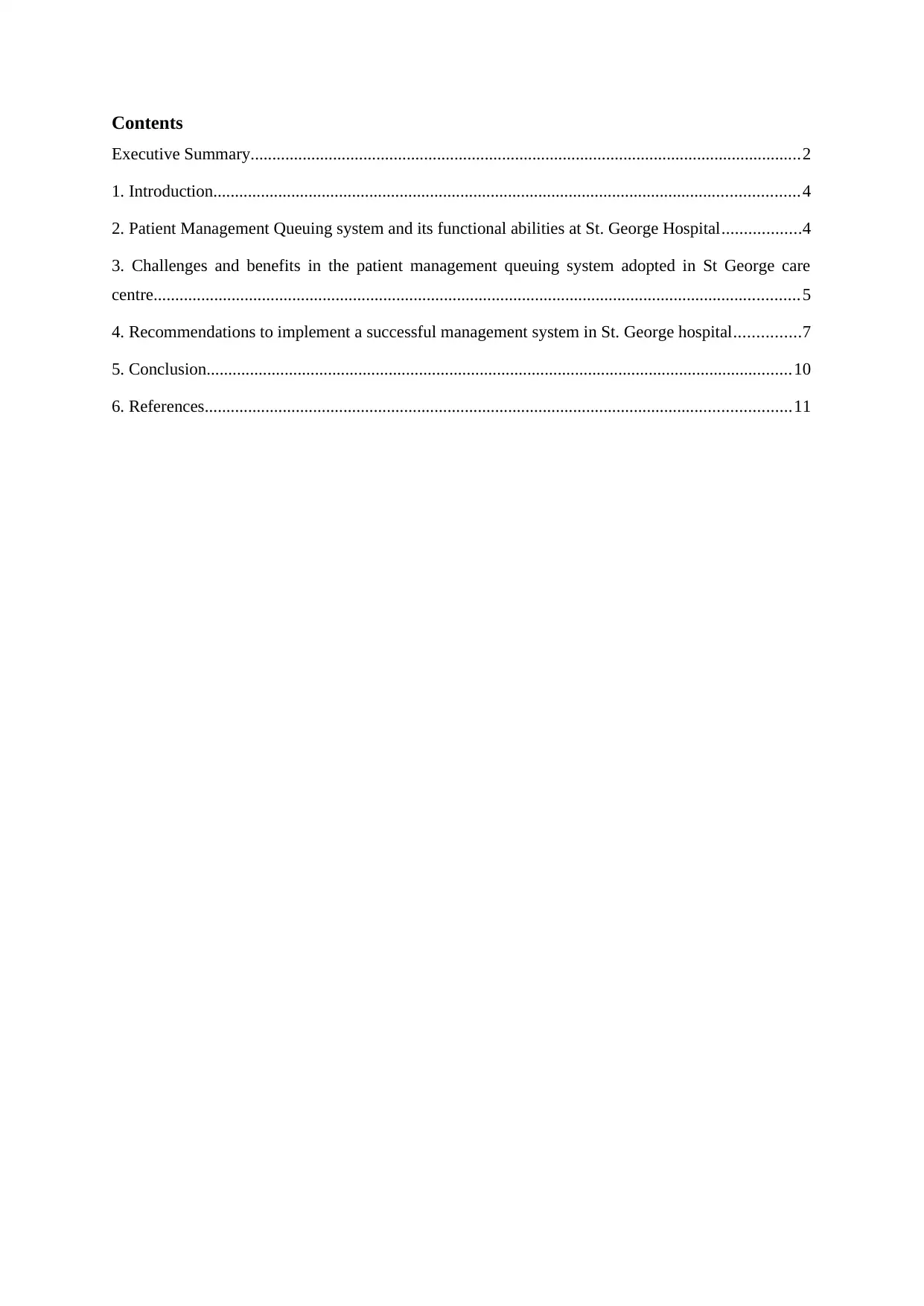
Contents
Executive Summary...............................................................................................................................2
1. Introduction.......................................................................................................................................4
2. Patient Management Queuing system and its functional abilities at St. George Hospital..................4
3. Challenges and benefits in the patient management queuing system adopted in St George care
centre.....................................................................................................................................................5
4. Recommendations to implement a successful management system in St. George hospital...............7
5. Conclusion.......................................................................................................................................10
6. References.......................................................................................................................................11
Executive Summary...............................................................................................................................2
1. Introduction.......................................................................................................................................4
2. Patient Management Queuing system and its functional abilities at St. George Hospital..................4
3. Challenges and benefits in the patient management queuing system adopted in St George care
centre.....................................................................................................................................................5
4. Recommendations to implement a successful management system in St. George hospital...............7
5. Conclusion.......................................................................................................................................10
6. References.......................................................................................................................................11
⊘ This is a preview!⊘
Do you want full access?
Subscribe today to unlock all pages.

Trusted by 1+ million students worldwide
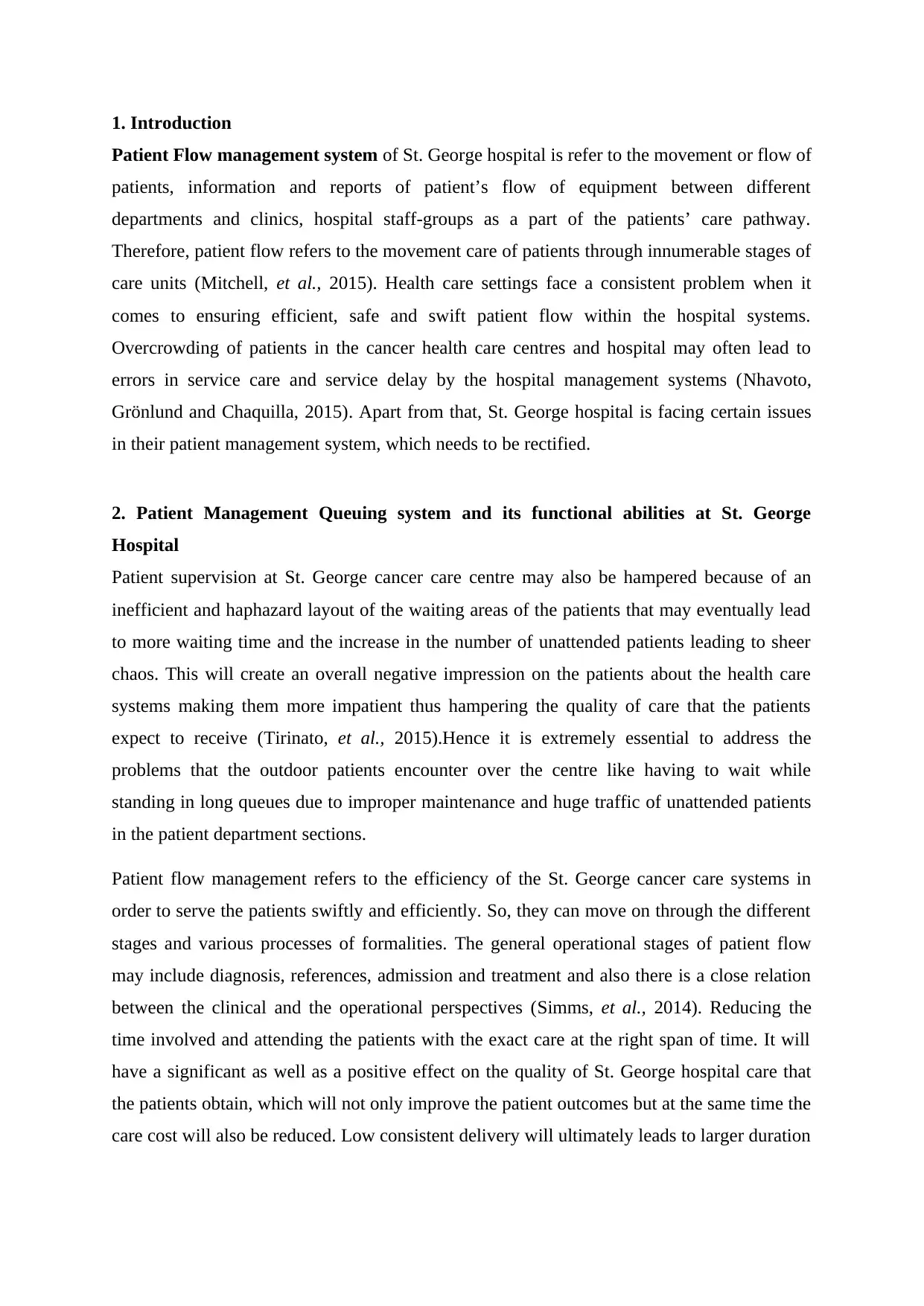
1. Introduction
Patient Flow management system of St. George hospital is refer to the movement or flow of
patients, information and reports of patient’s flow of equipment between different
departments and clinics, hospital staff-groups as a part of the patients’ care pathway.
Therefore, patient flow refers to the movement care of patients through innumerable stages of
care units (Mitchell, et al., 2015). Health care settings face a consistent problem when it
comes to ensuring efficient, safe and swift patient flow within the hospital systems.
Overcrowding of patients in the cancer health care centres and hospital may often lead to
errors in service care and service delay by the hospital management systems (Nhavoto,
Grönlund and Chaquilla, 2015). Apart from that, St. George hospital is facing certain issues
in their patient management system, which needs to be rectified.
2. Patient Management Queuing system and its functional abilities at St. George
Hospital
Patient supervision at St. George cancer care centre may also be hampered because of an
inefficient and haphazard layout of the waiting areas of the patients that may eventually lead
to more waiting time and the increase in the number of unattended patients leading to sheer
chaos. This will create an overall negative impression on the patients about the health care
systems making them more impatient thus hampering the quality of care that the patients
expect to receive (Tirinato, et al., 2015).Hence it is extremely essential to address the
problems that the outdoor patients encounter over the centre like having to wait while
standing in long queues due to improper maintenance and huge traffic of unattended patients
in the patient department sections.
Patient flow management refers to the efficiency of the St. George cancer care systems in
order to serve the patients swiftly and efficiently. So, they can move on through the different
stages and various processes of formalities. The general operational stages of patient flow
may include diagnosis, references, admission and treatment and also there is a close relation
between the clinical and the operational perspectives (Simms, et al., 2014). Reducing the
time involved and attending the patients with the exact care at the right span of time. It will
have a significant as well as a positive effect on the quality of St. George hospital care that
the patients obtain, which will not only improve the patient outcomes but at the same time the
care cost will also be reduced. Low consistent delivery will ultimately leads to larger duration
Patient Flow management system of St. George hospital is refer to the movement or flow of
patients, information and reports of patient’s flow of equipment between different
departments and clinics, hospital staff-groups as a part of the patients’ care pathway.
Therefore, patient flow refers to the movement care of patients through innumerable stages of
care units (Mitchell, et al., 2015). Health care settings face a consistent problem when it
comes to ensuring efficient, safe and swift patient flow within the hospital systems.
Overcrowding of patients in the cancer health care centres and hospital may often lead to
errors in service care and service delay by the hospital management systems (Nhavoto,
Grönlund and Chaquilla, 2015). Apart from that, St. George hospital is facing certain issues
in their patient management system, which needs to be rectified.
2. Patient Management Queuing system and its functional abilities at St. George
Hospital
Patient supervision at St. George cancer care centre may also be hampered because of an
inefficient and haphazard layout of the waiting areas of the patients that may eventually lead
to more waiting time and the increase in the number of unattended patients leading to sheer
chaos. This will create an overall negative impression on the patients about the health care
systems making them more impatient thus hampering the quality of care that the patients
expect to receive (Tirinato, et al., 2015).Hence it is extremely essential to address the
problems that the outdoor patients encounter over the centre like having to wait while
standing in long queues due to improper maintenance and huge traffic of unattended patients
in the patient department sections.
Patient flow management refers to the efficiency of the St. George cancer care systems in
order to serve the patients swiftly and efficiently. So, they can move on through the different
stages and various processes of formalities. The general operational stages of patient flow
may include diagnosis, references, admission and treatment and also there is a close relation
between the clinical and the operational perspectives (Simms, et al., 2014). Reducing the
time involved and attending the patients with the exact care at the right span of time. It will
have a significant as well as a positive effect on the quality of St. George hospital care that
the patients obtain, which will not only improve the patient outcomes but at the same time the
care cost will also be reduced. Low consistent delivery will ultimately leads to larger duration
Paraphrase This Document
Need a fresh take? Get an instant paraphrase of this document with our AI Paraphraser
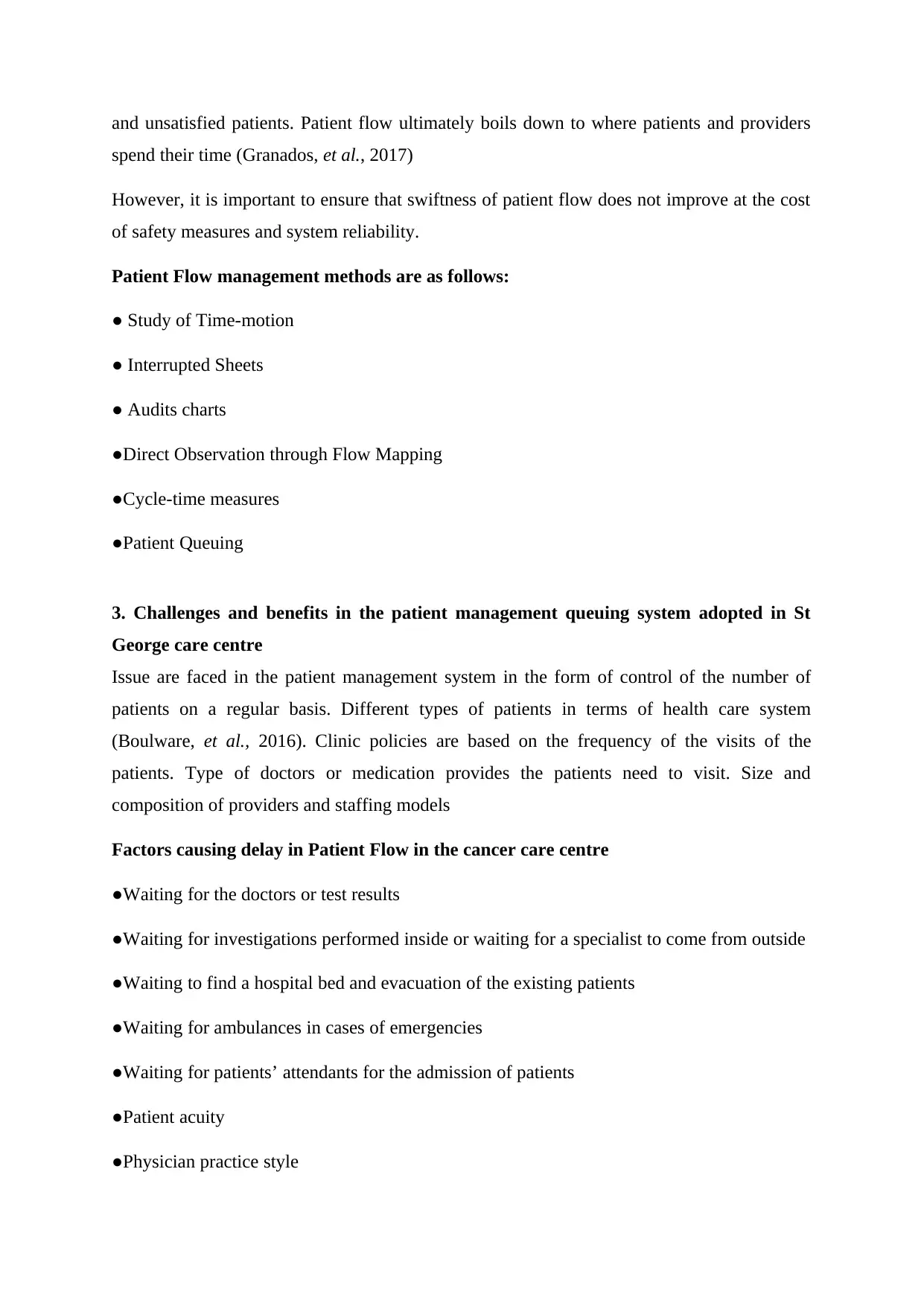
and unsatisfied patients. Patient flow ultimately boils down to where patients and providers
spend their time (Granados, et al., 2017)
However, it is important to ensure that swiftness of patient flow does not improve at the cost
of safety measures and system reliability.
Patient Flow management methods are as follows:
● Study of Time-motion
● Interrupted Sheets
● Audits charts
●Direct Observation through Flow Mapping
●Cycle-time measures
●Patient Queuing
3. Challenges and benefits in the patient management queuing system adopted in St
George care centre
Issue are faced in the patient management system in the form of control of the number of
patients on a regular basis. Different types of patients in terms of health care system
(Boulware, et al., 2016). Clinic policies are based on the frequency of the visits of the
patients. Type of doctors or medication provides the patients need to visit. Size and
composition of providers and staffing models
Factors causing delay in Patient Flow in the cancer care centre
●Waiting for the doctors or test results
●Waiting for investigations performed inside or waiting for a specialist to come from outside
●Waiting to find a hospital bed and evacuation of the existing patients
●Waiting for ambulances in cases of emergencies
●Waiting for patients’ attendants for the admission of patients
●Patient acuity
●Physician practice style
spend their time (Granados, et al., 2017)
However, it is important to ensure that swiftness of patient flow does not improve at the cost
of safety measures and system reliability.
Patient Flow management methods are as follows:
● Study of Time-motion
● Interrupted Sheets
● Audits charts
●Direct Observation through Flow Mapping
●Cycle-time measures
●Patient Queuing
3. Challenges and benefits in the patient management queuing system adopted in St
George care centre
Issue are faced in the patient management system in the form of control of the number of
patients on a regular basis. Different types of patients in terms of health care system
(Boulware, et al., 2016). Clinic policies are based on the frequency of the visits of the
patients. Type of doctors or medication provides the patients need to visit. Size and
composition of providers and staffing models
Factors causing delay in Patient Flow in the cancer care centre
●Waiting for the doctors or test results
●Waiting for investigations performed inside or waiting for a specialist to come from outside
●Waiting to find a hospital bed and evacuation of the existing patients
●Waiting for ambulances in cases of emergencies
●Waiting for patients’ attendants for the admission of patients
●Patient acuity
●Physician practice style
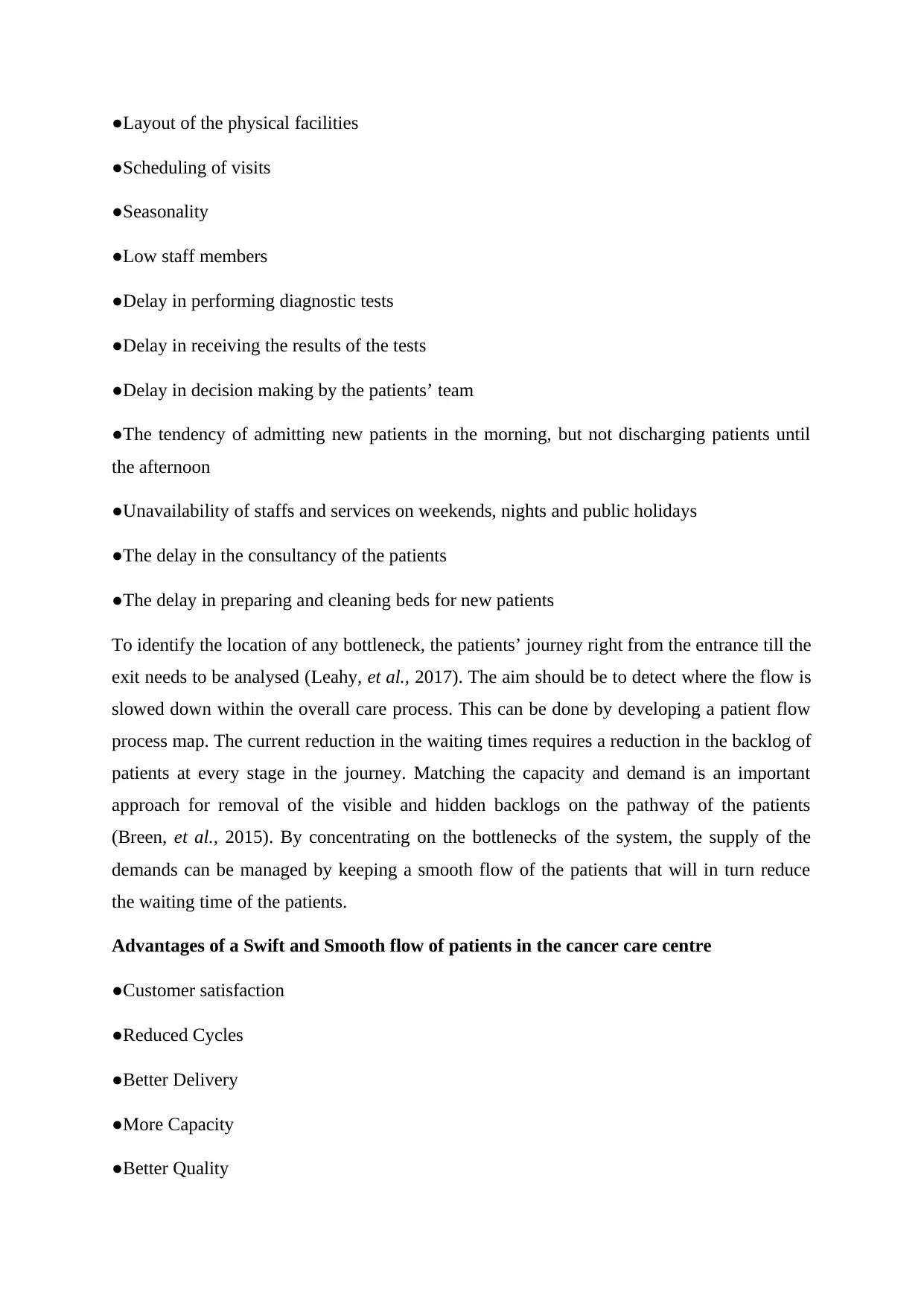
●Layout of the physical facilities
●Scheduling of visits
●Seasonality
●Low staff members
●Delay in performing diagnostic tests
●Delay in receiving the results of the tests
●Delay in decision making by the patients’ team
●The tendency of admitting new patients in the morning, but not discharging patients until
the afternoon
●Unavailability of staffs and services on weekends, nights and public holidays
●The delay in the consultancy of the patients
●The delay in preparing and cleaning beds for new patients
To identify the location of any bottleneck, the patients’ journey right from the entrance till the
exit needs to be analysed (Leahy, et al., 2017). The aim should be to detect where the flow is
slowed down within the overall care process. This can be done by developing a patient flow
process map. The current reduction in the waiting times requires a reduction in the backlog of
patients at every stage in the journey. Matching the capacity and demand is an important
approach for removal of the visible and hidden backlogs on the pathway of the patients
(Breen, et al., 2015). By concentrating on the bottlenecks of the system, the supply of the
demands can be managed by keeping a smooth flow of the patients that will in turn reduce
the waiting time of the patients.
Advantages of a Swift and Smooth flow of patients in the cancer care centre
●Customer satisfaction
●Reduced Cycles
●Better Delivery
●More Capacity
●Better Quality
●Scheduling of visits
●Seasonality
●Low staff members
●Delay in performing diagnostic tests
●Delay in receiving the results of the tests
●Delay in decision making by the patients’ team
●The tendency of admitting new patients in the morning, but not discharging patients until
the afternoon
●Unavailability of staffs and services on weekends, nights and public holidays
●The delay in the consultancy of the patients
●The delay in preparing and cleaning beds for new patients
To identify the location of any bottleneck, the patients’ journey right from the entrance till the
exit needs to be analysed (Leahy, et al., 2017). The aim should be to detect where the flow is
slowed down within the overall care process. This can be done by developing a patient flow
process map. The current reduction in the waiting times requires a reduction in the backlog of
patients at every stage in the journey. Matching the capacity and demand is an important
approach for removal of the visible and hidden backlogs on the pathway of the patients
(Breen, et al., 2015). By concentrating on the bottlenecks of the system, the supply of the
demands can be managed by keeping a smooth flow of the patients that will in turn reduce
the waiting time of the patients.
Advantages of a Swift and Smooth flow of patients in the cancer care centre
●Customer satisfaction
●Reduced Cycles
●Better Delivery
●More Capacity
●Better Quality
⊘ This is a preview!⊘
Do you want full access?
Subscribe today to unlock all pages.

Trusted by 1+ million students worldwide
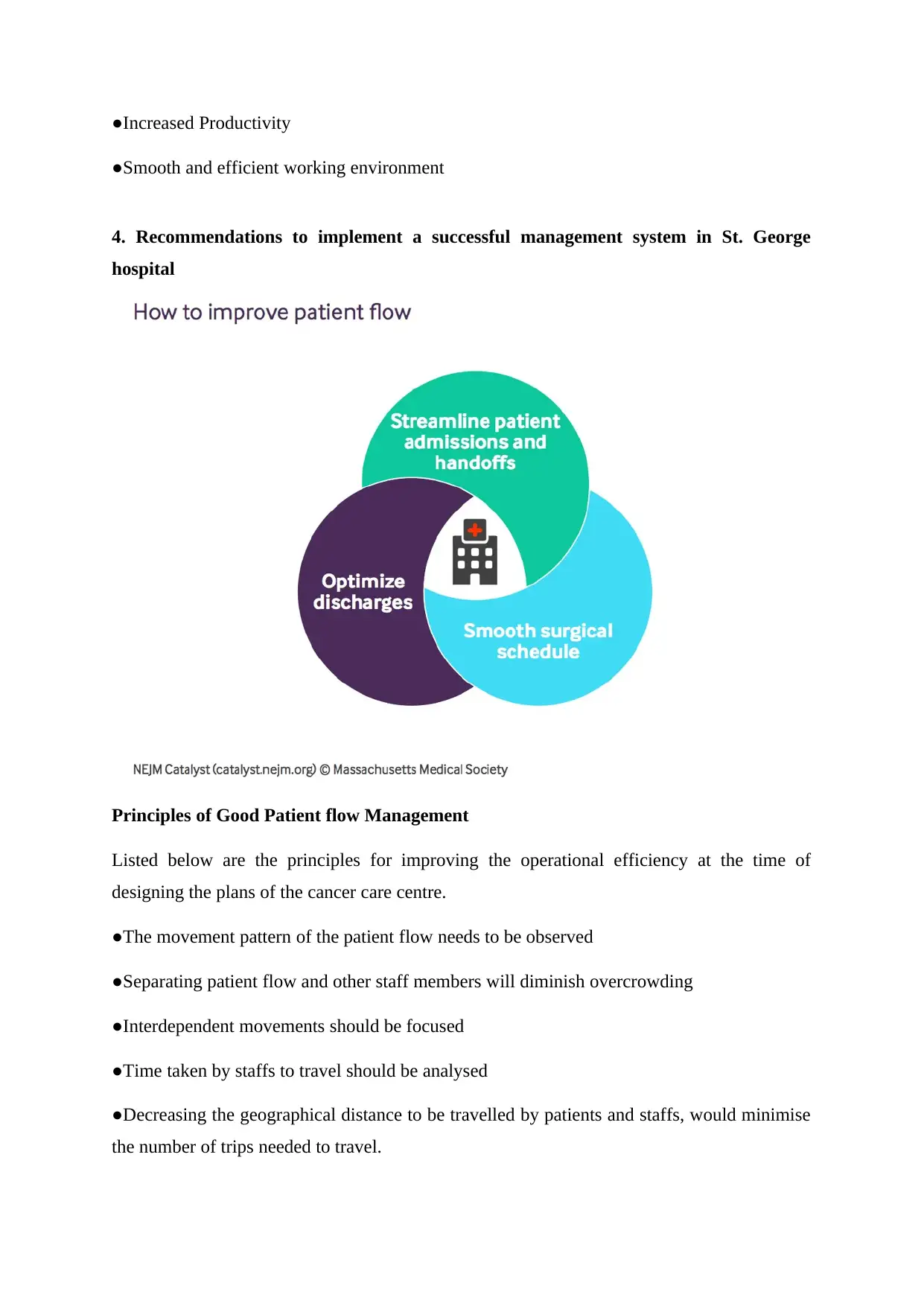
●Increased Productivity
●Smooth and efficient working environment
4. Recommendations to implement a successful management system in St. George
hospital
Principles of Good Patient flow Management
Listed below are the principles for improving the operational efficiency at the time of
designing the plans of the cancer care centre.
●The movement pattern of the patient flow needs to be observed
●Separating patient flow and other staff members will diminish overcrowding
●Interdependent movements should be focused
●Time taken by staffs to travel should be analysed
●Decreasing the geographical distance to be travelled by patients and staffs, would minimise
the number of trips needed to travel.
●Smooth and efficient working environment
4. Recommendations to implement a successful management system in St. George
hospital
Principles of Good Patient flow Management
Listed below are the principles for improving the operational efficiency at the time of
designing the plans of the cancer care centre.
●The movement pattern of the patient flow needs to be observed
●Separating patient flow and other staff members will diminish overcrowding
●Interdependent movements should be focused
●Time taken by staffs to travel should be analysed
●Decreasing the geographical distance to be travelled by patients and staffs, would minimise
the number of trips needed to travel.
Paraphrase This Document
Need a fresh take? Get an instant paraphrase of this document with our AI Paraphraser
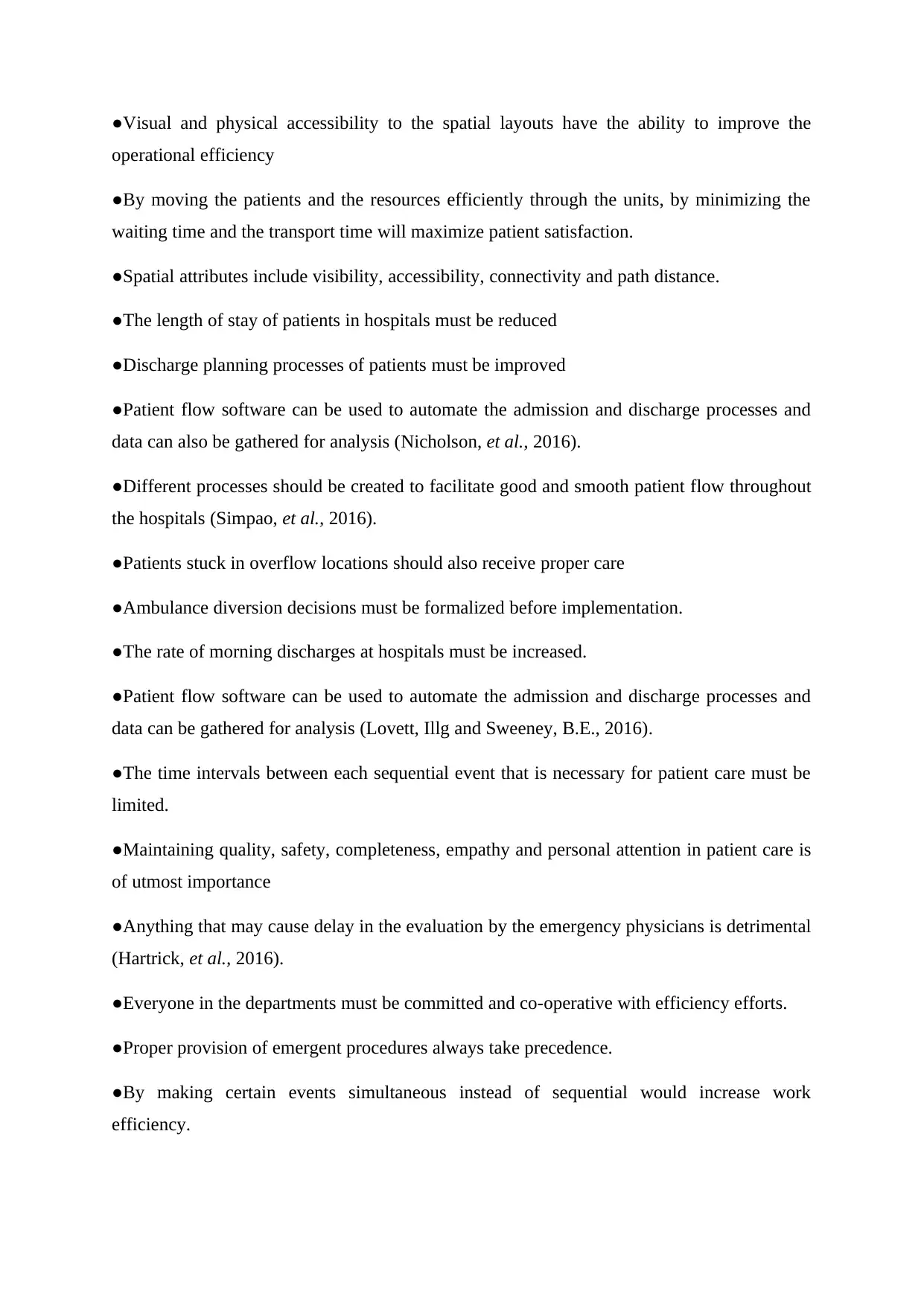
●Visual and physical accessibility to the spatial layouts have the ability to improve the
operational efficiency
●By moving the patients and the resources efficiently through the units, by minimizing the
waiting time and the transport time will maximize patient satisfaction.
●Spatial attributes include visibility, accessibility, connectivity and path distance.
●The length of stay of patients in hospitals must be reduced
●Discharge planning processes of patients must be improved
●Patient flow software can be used to automate the admission and discharge processes and
data can also be gathered for analysis (Nicholson, et al., 2016).
●Different processes should be created to facilitate good and smooth patient flow throughout
the hospitals (Simpao, et al., 2016).
●Patients stuck in overflow locations should also receive proper care
●Ambulance diversion decisions must be formalized before implementation.
●The rate of morning discharges at hospitals must be increased.
●Patient flow software can be used to automate the admission and discharge processes and
data can be gathered for analysis (Lovett, Illg and Sweeney, B.E., 2016).
●The time intervals between each sequential event that is necessary for patient care must be
limited.
●Maintaining quality, safety, completeness, empathy and personal attention in patient care is
of utmost importance
●Anything that may cause delay in the evaluation by the emergency physicians is detrimental
(Hartrick, et al., 2016).
●Everyone in the departments must be committed and co-operative with efficiency efforts.
●Proper provision of emergent procedures always take precedence.
●By making certain events simultaneous instead of sequential would increase work
efficiency.
operational efficiency
●By moving the patients and the resources efficiently through the units, by minimizing the
waiting time and the transport time will maximize patient satisfaction.
●Spatial attributes include visibility, accessibility, connectivity and path distance.
●The length of stay of patients in hospitals must be reduced
●Discharge planning processes of patients must be improved
●Patient flow software can be used to automate the admission and discharge processes and
data can also be gathered for analysis (Nicholson, et al., 2016).
●Different processes should be created to facilitate good and smooth patient flow throughout
the hospitals (Simpao, et al., 2016).
●Patients stuck in overflow locations should also receive proper care
●Ambulance diversion decisions must be formalized before implementation.
●The rate of morning discharges at hospitals must be increased.
●Patient flow software can be used to automate the admission and discharge processes and
data can be gathered for analysis (Lovett, Illg and Sweeney, B.E., 2016).
●The time intervals between each sequential event that is necessary for patient care must be
limited.
●Maintaining quality, safety, completeness, empathy and personal attention in patient care is
of utmost importance
●Anything that may cause delay in the evaluation by the emergency physicians is detrimental
(Hartrick, et al., 2016).
●Everyone in the departments must be committed and co-operative with efficiency efforts.
●Proper provision of emergent procedures always take precedence.
●By making certain events simultaneous instead of sequential would increase work
efficiency.
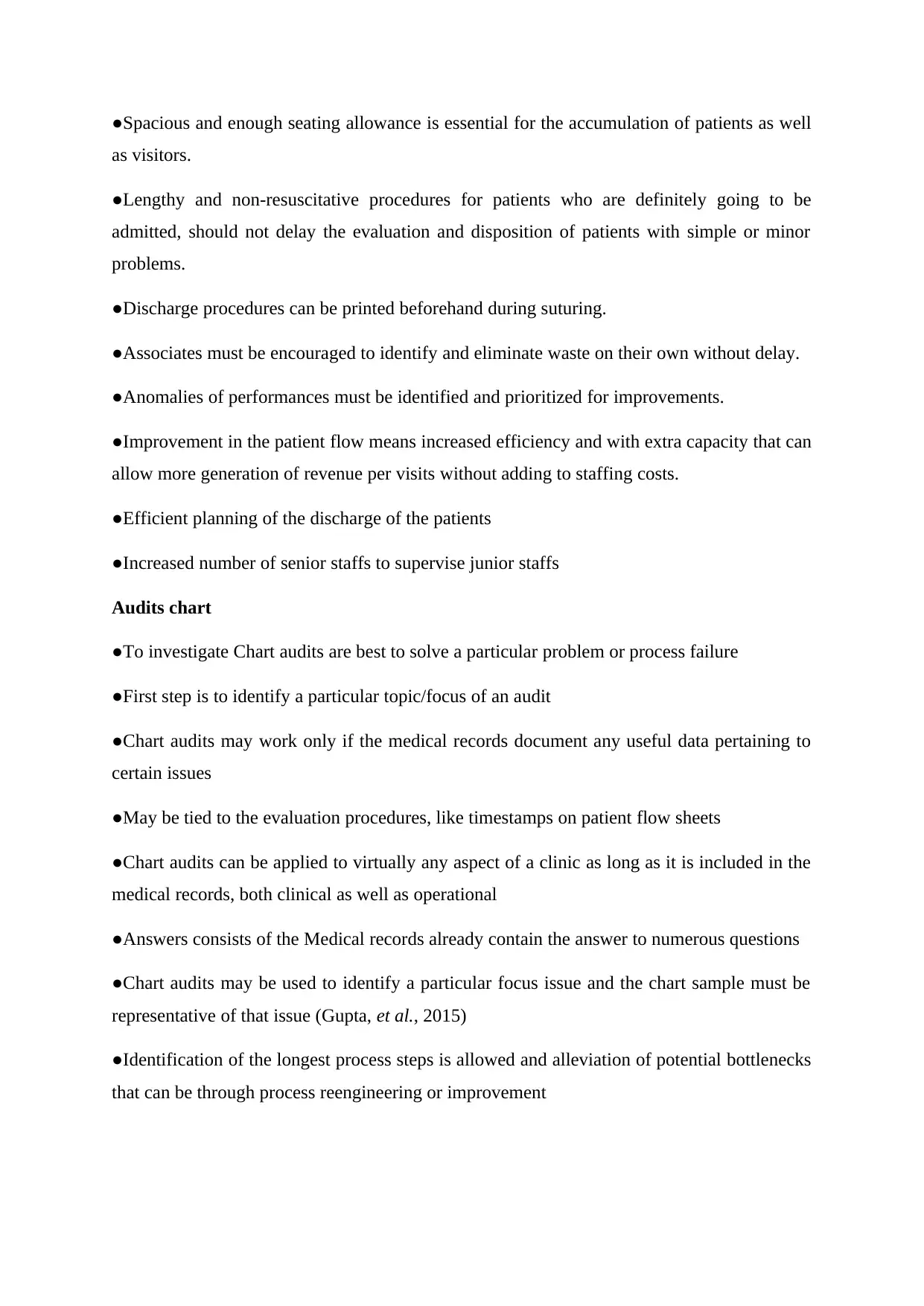
●Spacious and enough seating allowance is essential for the accumulation of patients as well
as visitors.
●Lengthy and non-resuscitative procedures for patients who are definitely going to be
admitted, should not delay the evaluation and disposition of patients with simple or minor
problems.
●Discharge procedures can be printed beforehand during suturing.
●Associates must be encouraged to identify and eliminate waste on their own without delay.
●Anomalies of performances must be identified and prioritized for improvements.
●Improvement in the patient flow means increased efficiency and with extra capacity that can
allow more generation of revenue per visits without adding to staffing costs.
●Efficient planning of the discharge of the patients
●Increased number of senior staffs to supervise junior staffs
Audits chart
●To investigate Chart audits are best to solve a particular problem or process failure
●First step is to identify a particular topic/focus of an audit
●Chart audits may work only if the medical records document any useful data pertaining to
certain issues
●May be tied to the evaluation procedures, like timestamps on patient flow sheets
●Chart audits can be applied to virtually any aspect of a clinic as long as it is included in the
medical records, both clinical as well as operational
●Answers consists of the Medical records already contain the answer to numerous questions
●Chart audits may be used to identify a particular focus issue and the chart sample must be
representative of that issue (Gupta, et al., 2015)
●Identification of the longest process steps is allowed and alleviation of potential bottlenecks
that can be through process reengineering or improvement
as visitors.
●Lengthy and non-resuscitative procedures for patients who are definitely going to be
admitted, should not delay the evaluation and disposition of patients with simple or minor
problems.
●Discharge procedures can be printed beforehand during suturing.
●Associates must be encouraged to identify and eliminate waste on their own without delay.
●Anomalies of performances must be identified and prioritized for improvements.
●Improvement in the patient flow means increased efficiency and with extra capacity that can
allow more generation of revenue per visits without adding to staffing costs.
●Efficient planning of the discharge of the patients
●Increased number of senior staffs to supervise junior staffs
Audits chart
●To investigate Chart audits are best to solve a particular problem or process failure
●First step is to identify a particular topic/focus of an audit
●Chart audits may work only if the medical records document any useful data pertaining to
certain issues
●May be tied to the evaluation procedures, like timestamps on patient flow sheets
●Chart audits can be applied to virtually any aspect of a clinic as long as it is included in the
medical records, both clinical as well as operational
●Answers consists of the Medical records already contain the answer to numerous questions
●Chart audits may be used to identify a particular focus issue and the chart sample must be
representative of that issue (Gupta, et al., 2015)
●Identification of the longest process steps is allowed and alleviation of potential bottlenecks
that can be through process reengineering or improvement
⊘ This is a preview!⊘
Do you want full access?
Subscribe today to unlock all pages.

Trusted by 1+ million students worldwide
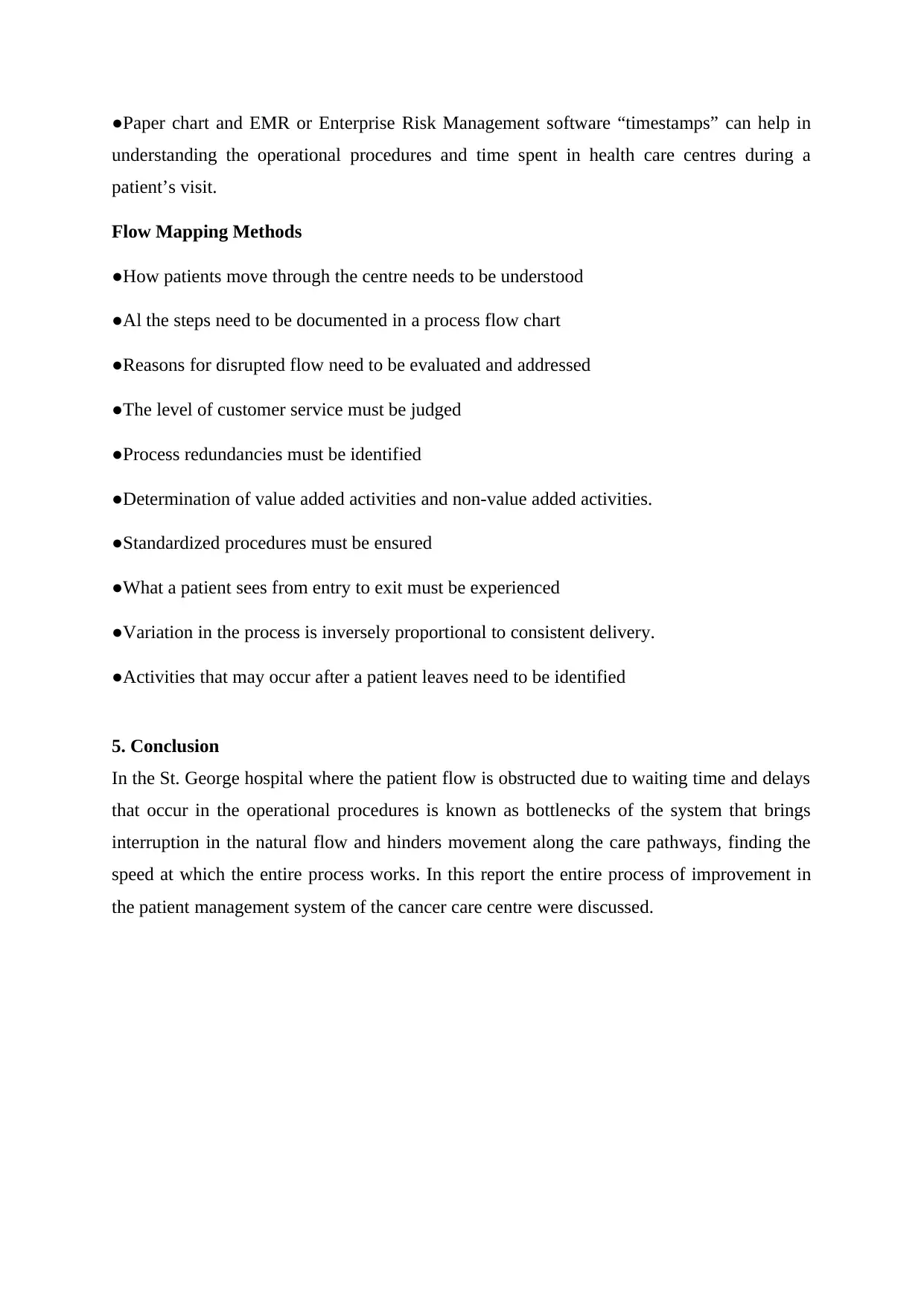
●Paper chart and EMR or Enterprise Risk Management software “timestamps” can help in
understanding the operational procedures and time spent in health care centres during a
patient’s visit.
Flow Mapping Methods
●How patients move through the centre needs to be understood
●Al the steps need to be documented in a process flow chart
●Reasons for disrupted flow need to be evaluated and addressed
●The level of customer service must be judged
●Process redundancies must be identified
●Determination of value added activities and non-value added activities.
●Standardized procedures must be ensured
●What a patient sees from entry to exit must be experienced
●Variation in the process is inversely proportional to consistent delivery.
●Activities that may occur after a patient leaves need to be identified
5. Conclusion
In the St. George hospital where the patient flow is obstructed due to waiting time and delays
that occur in the operational procedures is known as bottlenecks of the system that brings
interruption in the natural flow and hinders movement along the care pathways, finding the
speed at which the entire process works. In this report the entire process of improvement in
the patient management system of the cancer care centre were discussed.
understanding the operational procedures and time spent in health care centres during a
patient’s visit.
Flow Mapping Methods
●How patients move through the centre needs to be understood
●Al the steps need to be documented in a process flow chart
●Reasons for disrupted flow need to be evaluated and addressed
●The level of customer service must be judged
●Process redundancies must be identified
●Determination of value added activities and non-value added activities.
●Standardized procedures must be ensured
●What a patient sees from entry to exit must be experienced
●Variation in the process is inversely proportional to consistent delivery.
●Activities that may occur after a patient leaves need to be identified
5. Conclusion
In the St. George hospital where the patient flow is obstructed due to waiting time and delays
that occur in the operational procedures is known as bottlenecks of the system that brings
interruption in the natural flow and hinders movement along the care pathways, finding the
speed at which the entire process works. In this report the entire process of improvement in
the patient management system of the cancer care centre were discussed.
Paraphrase This Document
Need a fresh take? Get an instant paraphrase of this document with our AI Paraphraser
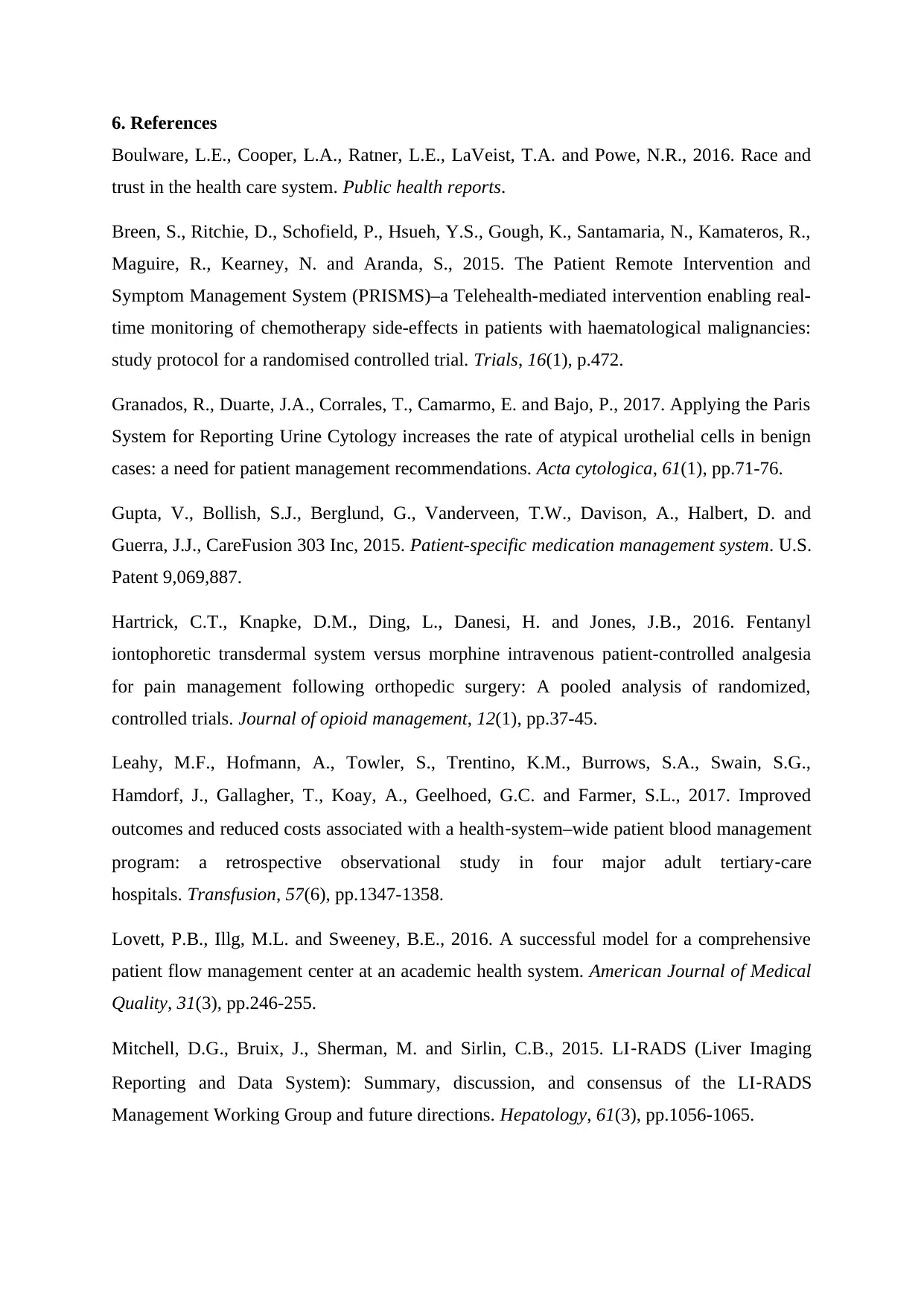
6. References
Boulware, L.E., Cooper, L.A., Ratner, L.E., LaVeist, T.A. and Powe, N.R., 2016. Race and
trust in the health care system. Public health reports.
Breen, S., Ritchie, D., Schofield, P., Hsueh, Y.S., Gough, K., Santamaria, N., Kamateros, R.,
Maguire, R., Kearney, N. and Aranda, S., 2015. The Patient Remote Intervention and
Symptom Management System (PRISMS)–a Telehealth-mediated intervention enabling real-
time monitoring of chemotherapy side-effects in patients with haematological malignancies:
study protocol for a randomised controlled trial. Trials, 16(1), p.472.
Granados, R., Duarte, J.A., Corrales, T., Camarmo, E. and Bajo, P., 2017. Applying the Paris
System for Reporting Urine Cytology increases the rate of atypical urothelial cells in benign
cases: a need for patient management recommendations. Acta cytologica, 61(1), pp.71-76.
Gupta, V., Bollish, S.J., Berglund, G., Vanderveen, T.W., Davison, A., Halbert, D. and
Guerra, J.J., CareFusion 303 Inc, 2015. Patient-specific medication management system. U.S.
Patent 9,069,887.
Hartrick, C.T., Knapke, D.M., Ding, L., Danesi, H. and Jones, J.B., 2016. Fentanyl
iontophoretic transdermal system versus morphine intravenous patient-controlled analgesia
for pain management following orthopedic surgery: A pooled analysis of randomized,
controlled trials. Journal of opioid management, 12(1), pp.37-45.
Leahy, M.F., Hofmann, A., Towler, S., Trentino, K.M., Burrows, S.A., Swain, S.G.,
Hamdorf, J., Gallagher, T., Koay, A., Geelhoed, G.C. and Farmer, S.L., 2017. Improved
outcomes and reduced costs associated with a health‐system–wide patient blood management
program: a retrospective observational study in four major adult tertiary‐care
hospitals. Transfusion, 57(6), pp.1347-1358.
Lovett, P.B., Illg, M.L. and Sweeney, B.E., 2016. A successful model for a comprehensive
patient flow management center at an academic health system. American Journal of Medical
Quality, 31(3), pp.246-255.
Mitchell, D.G., Bruix, J., Sherman, M. and Sirlin, C.B., 2015. LI‐RADS (Liver Imaging
Reporting and Data System): Summary, discussion, and consensus of the LI‐RADS
Management Working Group and future directions. Hepatology, 61(3), pp.1056-1065.
Boulware, L.E., Cooper, L.A., Ratner, L.E., LaVeist, T.A. and Powe, N.R., 2016. Race and
trust in the health care system. Public health reports.
Breen, S., Ritchie, D., Schofield, P., Hsueh, Y.S., Gough, K., Santamaria, N., Kamateros, R.,
Maguire, R., Kearney, N. and Aranda, S., 2015. The Patient Remote Intervention and
Symptom Management System (PRISMS)–a Telehealth-mediated intervention enabling real-
time monitoring of chemotherapy side-effects in patients with haematological malignancies:
study protocol for a randomised controlled trial. Trials, 16(1), p.472.
Granados, R., Duarte, J.A., Corrales, T., Camarmo, E. and Bajo, P., 2017. Applying the Paris
System for Reporting Urine Cytology increases the rate of atypical urothelial cells in benign
cases: a need for patient management recommendations. Acta cytologica, 61(1), pp.71-76.
Gupta, V., Bollish, S.J., Berglund, G., Vanderveen, T.W., Davison, A., Halbert, D. and
Guerra, J.J., CareFusion 303 Inc, 2015. Patient-specific medication management system. U.S.
Patent 9,069,887.
Hartrick, C.T., Knapke, D.M., Ding, L., Danesi, H. and Jones, J.B., 2016. Fentanyl
iontophoretic transdermal system versus morphine intravenous patient-controlled analgesia
for pain management following orthopedic surgery: A pooled analysis of randomized,
controlled trials. Journal of opioid management, 12(1), pp.37-45.
Leahy, M.F., Hofmann, A., Towler, S., Trentino, K.M., Burrows, S.A., Swain, S.G.,
Hamdorf, J., Gallagher, T., Koay, A., Geelhoed, G.C. and Farmer, S.L., 2017. Improved
outcomes and reduced costs associated with a health‐system–wide patient blood management
program: a retrospective observational study in four major adult tertiary‐care
hospitals. Transfusion, 57(6), pp.1347-1358.
Lovett, P.B., Illg, M.L. and Sweeney, B.E., 2016. A successful model for a comprehensive
patient flow management center at an academic health system. American Journal of Medical
Quality, 31(3), pp.246-255.
Mitchell, D.G., Bruix, J., Sherman, M. and Sirlin, C.B., 2015. LI‐RADS (Liver Imaging
Reporting and Data System): Summary, discussion, and consensus of the LI‐RADS
Management Working Group and future directions. Hepatology, 61(3), pp.1056-1065.
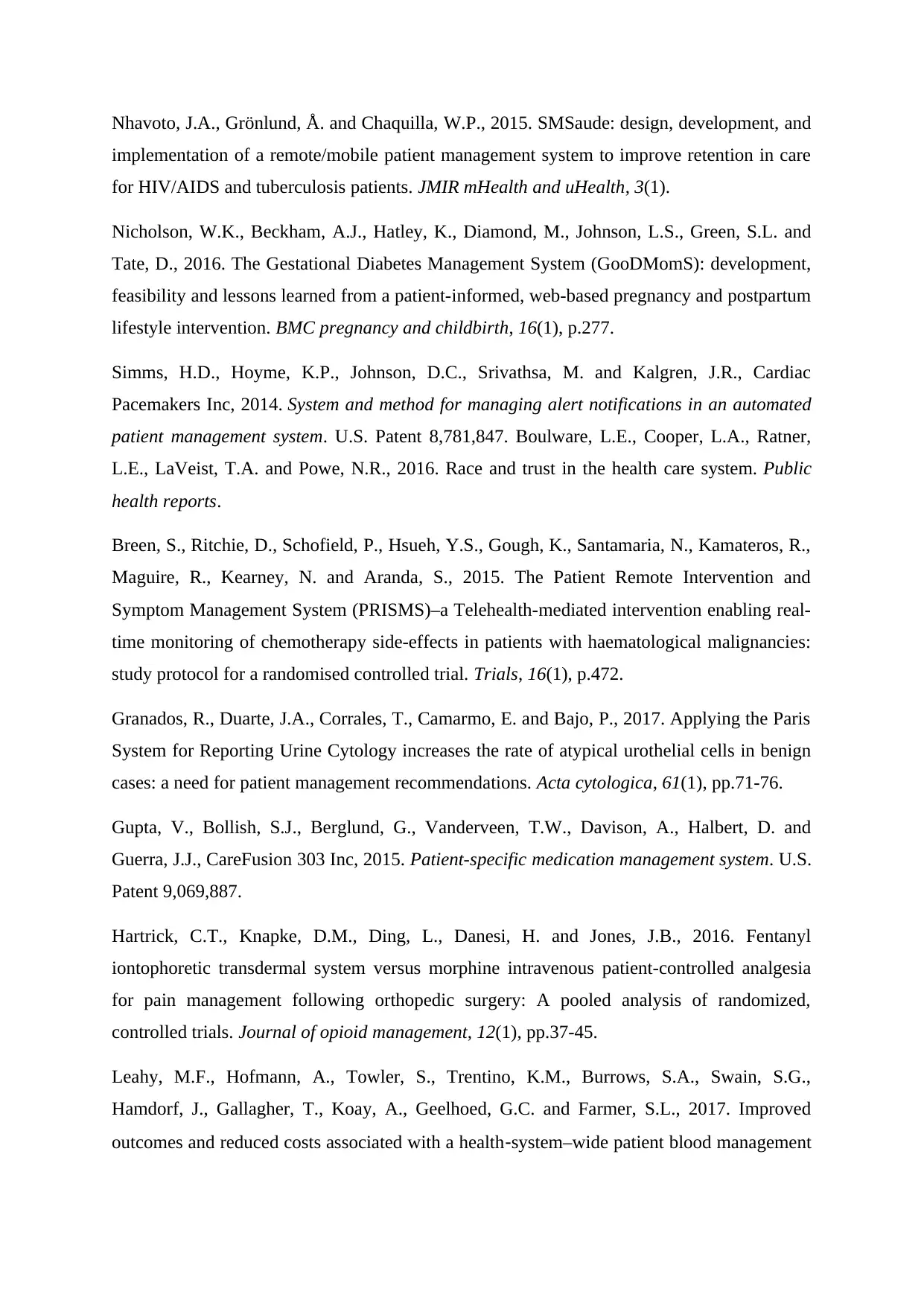
Nhavoto, J.A., Grönlund, Å. and Chaquilla, W.P., 2015. SMSaude: design, development, and
implementation of a remote/mobile patient management system to improve retention in care
for HIV/AIDS and tuberculosis patients. JMIR mHealth and uHealth, 3(1).
Nicholson, W.K., Beckham, A.J., Hatley, K., Diamond, M., Johnson, L.S., Green, S.L. and
Tate, D., 2016. The Gestational Diabetes Management System (GooDMomS): development,
feasibility and lessons learned from a patient-informed, web-based pregnancy and postpartum
lifestyle intervention. BMC pregnancy and childbirth, 16(1), p.277.
Simms, H.D., Hoyme, K.P., Johnson, D.C., Srivathsa, M. and Kalgren, J.R., Cardiac
Pacemakers Inc, 2014. System and method for managing alert notifications in an automated
patient management system. U.S. Patent 8,781,847. Boulware, L.E., Cooper, L.A., Ratner,
L.E., LaVeist, T.A. and Powe, N.R., 2016. Race and trust in the health care system. Public
health reports.
Breen, S., Ritchie, D., Schofield, P., Hsueh, Y.S., Gough, K., Santamaria, N., Kamateros, R.,
Maguire, R., Kearney, N. and Aranda, S., 2015. The Patient Remote Intervention and
Symptom Management System (PRISMS)–a Telehealth-mediated intervention enabling real-
time monitoring of chemotherapy side-effects in patients with haematological malignancies:
study protocol for a randomised controlled trial. Trials, 16(1), p.472.
Granados, R., Duarte, J.A., Corrales, T., Camarmo, E. and Bajo, P., 2017. Applying the Paris
System for Reporting Urine Cytology increases the rate of atypical urothelial cells in benign
cases: a need for patient management recommendations. Acta cytologica, 61(1), pp.71-76.
Gupta, V., Bollish, S.J., Berglund, G., Vanderveen, T.W., Davison, A., Halbert, D. and
Guerra, J.J., CareFusion 303 Inc, 2015. Patient-specific medication management system. U.S.
Patent 9,069,887.
Hartrick, C.T., Knapke, D.M., Ding, L., Danesi, H. and Jones, J.B., 2016. Fentanyl
iontophoretic transdermal system versus morphine intravenous patient-controlled analgesia
for pain management following orthopedic surgery: A pooled analysis of randomized,
controlled trials. Journal of opioid management, 12(1), pp.37-45.
Leahy, M.F., Hofmann, A., Towler, S., Trentino, K.M., Burrows, S.A., Swain, S.G.,
Hamdorf, J., Gallagher, T., Koay, A., Geelhoed, G.C. and Farmer, S.L., 2017. Improved
outcomes and reduced costs associated with a health‐system–wide patient blood management
implementation of a remote/mobile patient management system to improve retention in care
for HIV/AIDS and tuberculosis patients. JMIR mHealth and uHealth, 3(1).
Nicholson, W.K., Beckham, A.J., Hatley, K., Diamond, M., Johnson, L.S., Green, S.L. and
Tate, D., 2016. The Gestational Diabetes Management System (GooDMomS): development,
feasibility and lessons learned from a patient-informed, web-based pregnancy and postpartum
lifestyle intervention. BMC pregnancy and childbirth, 16(1), p.277.
Simms, H.D., Hoyme, K.P., Johnson, D.C., Srivathsa, M. and Kalgren, J.R., Cardiac
Pacemakers Inc, 2014. System and method for managing alert notifications in an automated
patient management system. U.S. Patent 8,781,847. Boulware, L.E., Cooper, L.A., Ratner,
L.E., LaVeist, T.A. and Powe, N.R., 2016. Race and trust in the health care system. Public
health reports.
Breen, S., Ritchie, D., Schofield, P., Hsueh, Y.S., Gough, K., Santamaria, N., Kamateros, R.,
Maguire, R., Kearney, N. and Aranda, S., 2015. The Patient Remote Intervention and
Symptom Management System (PRISMS)–a Telehealth-mediated intervention enabling real-
time monitoring of chemotherapy side-effects in patients with haematological malignancies:
study protocol for a randomised controlled trial. Trials, 16(1), p.472.
Granados, R., Duarte, J.A., Corrales, T., Camarmo, E. and Bajo, P., 2017. Applying the Paris
System for Reporting Urine Cytology increases the rate of atypical urothelial cells in benign
cases: a need for patient management recommendations. Acta cytologica, 61(1), pp.71-76.
Gupta, V., Bollish, S.J., Berglund, G., Vanderveen, T.W., Davison, A., Halbert, D. and
Guerra, J.J., CareFusion 303 Inc, 2015. Patient-specific medication management system. U.S.
Patent 9,069,887.
Hartrick, C.T., Knapke, D.M., Ding, L., Danesi, H. and Jones, J.B., 2016. Fentanyl
iontophoretic transdermal system versus morphine intravenous patient-controlled analgesia
for pain management following orthopedic surgery: A pooled analysis of randomized,
controlled trials. Journal of opioid management, 12(1), pp.37-45.
Leahy, M.F., Hofmann, A., Towler, S., Trentino, K.M., Burrows, S.A., Swain, S.G.,
Hamdorf, J., Gallagher, T., Koay, A., Geelhoed, G.C. and Farmer, S.L., 2017. Improved
outcomes and reduced costs associated with a health‐system–wide patient blood management
⊘ This is a preview!⊘
Do you want full access?
Subscribe today to unlock all pages.

Trusted by 1+ million students worldwide
1 out of 14
Related Documents
Your All-in-One AI-Powered Toolkit for Academic Success.
+13062052269
info@desklib.com
Available 24*7 on WhatsApp / Email
![[object Object]](/_next/static/media/star-bottom.7253800d.svg)
Unlock your academic potential
Copyright © 2020–2025 A2Z Services. All Rights Reserved. Developed and managed by ZUCOL.





